Once fall arrives and plants begin to go dormant, food sources for wildlife can become scarce. This is a critical problem, particularly for birds needing a diet rich in carbohydrates and fats to help them survive freezing weather. One obvious way to solve the problem for birds is to set up feeders and keep them filled over winter with calorie-rich seeds, suet, and dried fruits. A more significant way we can help is to incorporate landscape plants, such as the ones described below, that offer shelter, cover from predators, and a variety of foods that nourish birds as well as other wildlife species in the colder months.
BERRIES AND FRUITS FOR WILDLIFE
A number of plants bear berries and fruits that are valuable to wildlife in winter. The plants described below are just a few examples.
American Beautyberry (Callicarpa americana) – In spring and summer, this shrub is rather ordinary looking, but come late August, it puts on a show with its stunning purple berry display. The berries, which grow in dense clusters along the branches, last into mid-winter. They are a winter favorite for birds such as mockingbirds, robins, cardinals, finches, and towhees. They also attract squirrels, raccoons, and foxes.
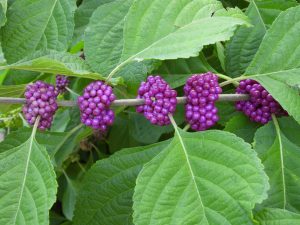
American Crabapple (Malus coronaria) – This small landscape tree is an excellent food source for wildlife. The tiny tart-tasting crabapples ripen in September and often fall to the ground where they can remain over winter. On the one hand, the fallen fruit can make a gooey mess on your lawn, especially as the winter temperatures soften the fruit. On the other hand, crabapples feed wildlife such as turkeys, raccoons and a variety of birds when other foods are scarce. Deer enjoy crabapples as well, so keep that in mind if you don’t want to attract these four-footed creatures to your yard.
American Holly (Ilex opaca) – The dense foliage of this evergreen species provides shelter to birds in winter and cover from predators. The berries aren’t particularly palatable to birds. However, when faced with few alternative food sources in winter, birds will eat the berries after they have gone through several freezing and thawing cycles. American holly is dioecious, which means the plants are either male or female. To bear fruit, a female tree must be planted within about 40 feet of a male tree.
American Persimmon (Diospyros virginiana) – This slow-growing tree can reach 80’ tall and is typically found in mixed hardwood forests rather than in residential landscapes. However, if you have the space for this tree, you will be amazed at the wildlife it can support. In spring, the blossoms attract honeybees, bumblebees, mason, leaf-cutting and other bees. In fall, the fruits are very astringent and inedible until frosts sweeten the fruit rendering it edible to deer, songbirds, wild turkeys, rabbits, opossums, raccoons, squirrels and more.

Chokeberry (Aronia species) – This shrub gets its name from the tart, bitter-tasting fruits, which require some time to mellow before they can be eaten. In spring, the flowers provide nectar and pollen for beneficial insects and then give way to either black (A. melanocarpa) or red (A. arbutifolia) berries, depending on the species. The berries are high in antioxidants, persist through fall and winter, and are consumed by a variety of birds, including grosbeaks, bluejays, bluebirds, catbirds, robins, thrushes, and ruffed grouse. Some bird species are thought to prefer the black berries over the red ones. The berries also feed deer, bear, mice, voles, chipmunks, foxes, rabbits, squirrels, and skunks.
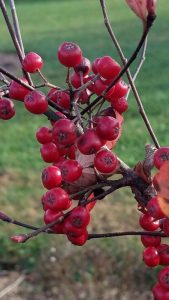
Eastern Redcedar (Juniperus virginiana) – This evergreen tree’s bluish-black berry-like fruit is an important food source for the cedar waxwing bird as well as other birds and mammals. The dense foliage provides nesting sites and roosting cover in winter for a variety of birds, including chipping sparrows, robins, song sparrows, mockingbirds, juncos and warblers. To learn more about this native tree, see “The Pros and Cons of the Eastern Redcedar.”
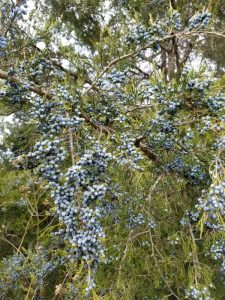
Spicebush (Lindera benzoin) – This dioecious shrub flowers early in spring when not much else is in bloom. It is a larval host plant for two swallowtail butterfly species – the spicebush swallowtail and the giant Prometheus silk moth. The female spicebush plant bears drupes which turn bright red as they ripen in September. The drupes have a peppery taste and scent. Their high fat content makes them an important food source for fall-migrating songbirds as well as wildlife, such as opossums, raccoons, and squirrels.
Viburnum species. Native to Virginia, Southern Arrowwood (V. dentatum), Mapleleaf (V. acerifolium), Nannyberry (V. lentago), Possumhaw (V. nudum), and Smooth Blackhaw (V. prunifolium) shrubs all produce large quantities of berries in fall. Although acidic, the berries are edible and attract a variety of bird species. Depending on the variety, some viburnum species may be dioecious, requiring both a male and a female plant to develop berries. To learn more, see Viburnum–A Shrub for Many Settings.
Winterberry (Ilex verticillata) – The colorful berries of this dioecious plant persist on the female shrub all winter but need to undergo frosty conditions to soften them before they become palatable. When other sources of food are particularly scarce, a flock of migrating robins can strip this shrub of its berries in just one day. Other species that feed on winterberries include ruffed grouse, bobwhites, cedar waxwings, bluebirds, thrushes, woodpeckers, catbirds, flickers, ducks, wild turkeys and some small mammals, such as mice, raccoons, and squirrels.
SEED AND NUT-BEARING TREES AND SHRUBS
Nuts and seeds (referred to as hard mast) are significant sources of carbohydrates, protein, and fat in the diet of many wildlife species as they bulk up for winter. Some of the native nut-bearing shrubs and trees described below can be enjoyed by both humans and wildlife species alike.
American Beech (Fagus grandifolia) – The American Beech is a medium to large tree that can grow to 100 feet tall. It is best suited for parks or other open areas that can accommodate its large size. In addition to providing shelter and habitat, this tree produces spiny, triangular-shaped edible nuts that are a food source to a variety of mammals, such as mice, squirrels, chipmunks, foxes, deer, ruffed grouse, ducks, and bears, and to many bird species, such as woodpeckers, blue jays, turkeys, ducks, titmice and nuthatches.
American Hazelnut (Corylus americana) – The nuts of this shrub or small tree are enclosed in a leafy-fringed looking covering. They are considered to be a valuable food source for wildlife species, including squirrels, woodpeckers, turkeys, squirrels, deer and black bears. The plant spreads by underground rhizomes into dense thickets, which provide good cover and nesting sites for birds and small mammals. The nut is similar in taste to filberts (Hazelnuts) that are grown commercially. To learn more about this valuable nut-bearing plant, see Hazelnuts.
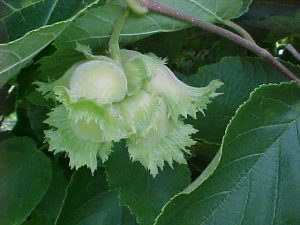
Alleghany Chinkapin (Castanea pumila) – Also referred to as chinquapin, this is a monoecious (both male and female flowers are on the same plant), multi-stemmed shrub or small 10’ to 15’ tall tree. Chinkapin nuts have a sweet flavor that is palatable to humans as well as to a variety of birds, including blue jays and woodpeckers and mammals such as chipmunks, squirrels, deer, and opossums. The nuts can be difficult to harvest and are not grown commercially.
Black Walnut (Juglans nigra) –A mature walnut tree can grow 80’ to 100+’ tall and wide, making it unsuitable for small landscapes. It needs plenty of room to spread. It provides shelter, nesting sites and cover for many bird and small mammal species. The edible nuts are enclosed in a very hard shell. Squirrels, turkeys, woodpeckers, raccoons, foxes and bears eat the nuts, but deer tend to leave them alone. In a good year with plenty of rain, a mature specimen can produce thousands of nuts that fall to the ground in early fall. That’s good news for wildlife but can be a big mess for a homeowner to deal with.
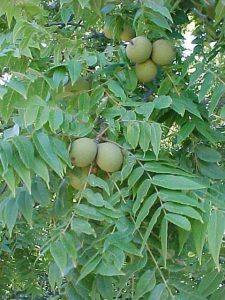
Hickory (Carya species) – The nuts, leaves, flowers, and bark of this large tree are eaten by a variety of wildlife species. The larvae of about 200 species of moths and butterflies feed on hickory foliage and provide an important source of protein for young birds. The nuts have hard husks, but woodpeckers, blue jays, wild turkeys and other birds with strong beaks are able to crack them open to get to the nuts within. In addition, the nuts attract squirrels, chipmunks, foxes, rabbits, turkeys, deer, and bear.
Oak species (Quercus) –Oak trees, particularly white oaks, are the acknowledged champions of trees that support an amazing number of wildlife species, particularly insects and their larvae. The acorns are an important food source for many bird species such as nuthatches, blue jays, crows, woodpeckers, ducks, and wild turkeys. Mammal species such as squirrels, chipmunks, raccoons, opossums, black bears and deer depend on the acorns for food over the harsh winter months.
Witch Hazel (Hamamelis virginiana) – In addition to attracting lots of pollinator insect species, this small, multi-stemmed tree provides food, cover and nesting habitat for birds. Witch hazel fruits, which present as small green seed capsules, develop on the plant in early winter after the plant finishes blooming. The capsules hang onto the branches until the following fall, at which time they drop and are consumed by ruffed grouse, northern bobwhite, ring-necked pheasant, deer and rabbits in addition to more than 40 different bird species.
SEED-BEARING HERBACEOUS PLANTS FOR WILDLIFE
Herbaceous plants, particularly native perennial species, are an important source of seeds as well as habitat for wildlife in winter. If you are a “tidy” gardener, resist the urge to cut down the foliage and stems of healthy annuals and perennials in fall. Many of those plants have seeds that persist through winter. It’s better to leave the plants standing for the birds to enjoy over winter and then cut them back in spring.
Here’s a sampling of herbaceous plants that provide good winter forage for seed-eating birds:
- Anise hyssop (Agastache foeniculum)
- Aster (Symphyotrichum species)
- Bee balm (Monarda species)
- Black-eyed Susan (Rudbeckia species)
- Blazing Star (Liatris species)
- Butterfly Weed (Asclepias tuberosa)
- Common Milkweed (Asclepias syriaca)
- Common yarrow (Achillea millefolium)
- False Indigo (Baptisia australis)
- False sunflower (Heliopsis helianthoides)
- Goldenrod (Solidago species)
- Native Grasses such as Switchgrass (Panicum virgatum) or Little Bluestem (Schizachyrium scoparium)
- Purple coneflower (Echinacea purpurea)
- Rattlesnake Master (Eryngium yuccifolium)
- Sunflower (Helianthus species)
SUMMARY
If we wish to support wildlife in winter, we could just install a bird feeder, fill it with seeds, and call it a day. But a better solution, as recommended by Carol Heiser, Wildlife Habitat Education Coordinator with the Virginia Department of Game and Inland Fisheries, is to “consider improving the habitat around your home, as well as the habitats found in public spaces in your community.” We can accomplish this by installing native plants that provide seeds, nuts, fruits and berries in fall and winter as well as plants that provide shelter and cover for a variety of wildlife species.
On a related topic that describes how wildlife species cope with wintry conditions, see Animals in Winter.
FEATURE PHOTO: Chokeberry (Aronia arbutifolia) berries. Photo by Pat Chadwick
SOURCES:
Audubon Native Plants Database, Find Bird-Friendly Native Plants (searchable by zip code).
Components of a Backyard Wildlife Habitat, Bulletin # 7137, University of Maine Cooperative Extension.
Feeding Wildlife: Food for Thought by Carol A. Heiser, Wildlife Habitat Education Coordinator with the Virginia Department of Game and Inland Fisheries
Habitat Gardening for Wildlife, Virginia Cooperative Extension, prepared by Carol A. Heiser, Virginia Department of Game and Inland Fisheries (2015)
Native Fruit and Nut Trees and Shrubs of the Virginia Mountains and Piedmont, Virginia Cooperative Extension Publication ANR-23NP